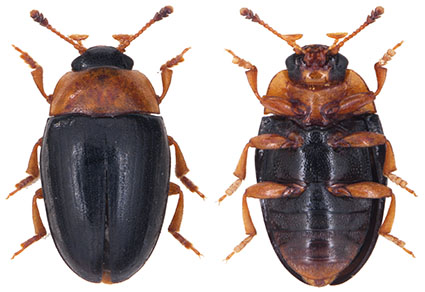Abstract
The status of Triplax collaris sulphuricollis Reitter, 1887 is reevaluated based on recent records from the Hyrcanian forests in northern Iran. Morphological features and barcoding support separate species status as Triplax sulphuricollis Reitter, 1887, new status. Morphological characteristics include an orange-yellow antennal club and elytral punctation arranged in striae. Triplax sulphuricollis is associated with oyster fungi of the genus Pleurotus growing on dead wood of deciduous trees.
References
Alekseev, V.I. (2014) A new species of Triplax Herbst, 1793 (Coleoptera: Erotylidae) from Bitterfeld amber. Baltic Journal of Coleopterology, 14 (2), 171–177.
Bekchiev, R., Smets, K. & Crevecoeur, L. (2012) Contribution to the knowledge of the genus Triplax Herbst, 1793 (Coleoptera: Erotylidae) in Bulgaria. ZooNotes, 30, 1–6.
Eckelt, A., Müller, J., Bense, U., Brustel, H., Bußler, H., Chittaro, Y., Cizek, L., Frei, A., Holzer, E., Kadej, M., Kahlen, M., Köhler, F., Möller, G., Mühle, H., Sanchez, A., Schaffrath, U., Schmidl, J., Smolis, A., Szallies, A., Németh, T., Wurst, C., Thorn, S., Christensen, R.H.B. & Seibold, S. (2018) “Primeval forest relict beetles” of Central Europe: a set of 168 umbrella species for the protection of primeval forest remnants. Journal of Insect Conservation, 22, 15–28. http://dx.doi.org/10.1007/s10841-017-0028-6
Folmer, O., Black, M., Hoeh, W., Lutz, R. & Vrijenhoek, R. (1994) DNA primers for amplification of mitochondrial cytochrome c oxidase subunit I from diverse metazoan invertebrates. Molecular Marine Biology and Biotechnology, 3 (5), 294–299.
Franc, V. (2001) Beetles of the family Erotylidae (Coleoptera) in the Slovakian fauna. Acta Zoologica Universitatis Comeniae, 44, 63–69.
Gholizadeh, H., Naqinezhad, A. & Chytrý, M. (2019) Classification of the Hyrcanian forest vegetation, northern Iran. Applied Vegetation Science, 23 (1), 107–126. https://doi.org/10.1111/avsc.12469
Hausmann, A., Godfray, H.C.J., Huemer, P., Mutanen, M., Rougerie, R., van Nieukerken, E.J., Ratnasingham, S. & Hebert, P.D.N. (2013) Genetic patterns in European Geometrid moths revealed by the Barcode Index Number (BIN) system. PLoS ONE, 8, e84518. https://doi.org/10.1371/journal.pone.0084518
Iablokoff-Khnzorian, S.M. (1975) Etude sur les Erotylidae (Coleoptera) Paléarctiques. Acta Zoologia Cracoviensia, 20 (8), 201–249, pls. 13–20. [in French]
Jacobson, G.G. (1915) Beetles of Russia, Western Europe and neighbouring countries. Debriena, St. Petersburg, 1024 pp. [in Russian]
Jarzabek-Müller, A., Morinière, J., Varandi, H.B. & Müller, J. (2017) Synaptus iranicus sp. nov., a second species of the genus Synaptus Eschscholtz, 1829 from Iran (Coleoptera: Elateridae) discovered by an integrative approach. Zootaxa, 4232 (4), 568–574. https://doi.org/10.11646/zootaxa.4232.4.6
Kumar, S., Stecher, G., Li, M., Knyaz, C. & Tamura, K. (2018) MEGA X: Molecular evolutionary genetics analysis across computing platforms. Molecular Biology and Evolution, 35 (6), 1547–1549. https://doi.org/10.1093/molbev/msy096
Lompe, A. (1989) Ein bewährtes Einbettungsmittel für Insektenpräparate. In: Lohse, G.A. & Lucht, W. (Eds.), Die Käfer Mitteleuropas, 1. Supplementband. Goecke & Evers, Krefeld, pp. 17–18.
Müller, J., Sagheb-Talebi, K. & Thorn, S. (2017) Protect Iran’s ancient forest from logging. Science, 355 (6328), 919. https://doi.org/10.1126/science.aam8810
Müller, J., Thorn, S., Baier, R., Khosro, S.-T., Barimani, H. V., Seibold, S., Ulyshen, M.D. & Gossner, M.M. (2016) Protecting the forests while allowing removal of damaged trees may imperil saproxylic insect biodiversity in the Hyrcanian beech forests of Iran. Conservation Letters, 9 (2), 106–113. https://doi.org/10.1111/conl.12187
Müller, J., Varandi, H.B., Babaii, M.R., Farashiani, M.E., Sageb-Talebi, K., Lange, F., Gossner, M.M., Jarzabek-Müller, A., Roth, N., Thorn, S. & Seibold, S. (2018) The diversity of saproxylic insects (Coleoptera, Heteroptera) on four tree species of the Hyrcanian forest in Iran. Journal of Insect Conservation, 22, 607–625. https://doi.org/10.1007/s10841-018-0089-1
Nei, M. & Kumar, S. (2000) Molecular Evolution and Phylogenetics. Oxford University Press, New York, 352 pp.
Puillandre, N., Lambert, A., Brouillet, S. & Achaz, G. (2012) ABGD, Automatic Barcode Gap Discovery for primary species delimitation. Molecular Ecology, 21 (8), 1864–1877. https://doi.org/10.1111/j.1365-294X.2011.05239.x
Ratnasingham, S. & Hebert, P.D.N. (2007) bold: The Barcode of Life Data System (http://www.barcodinglife.org). Molecular Ecology Notes, 7 (3), 355–364. https://doi.org/10.1111/j.1471-8286.2007.01678.x
Ratnasingham, S. & Hebert, P.D.N. (2013) A DNA-based registry for all animal species: the Barcode Index Number (BIN) system. PLoS ONE, 8 (8), e66213. https://doi.org/10.1371/journal.pone.0066213
Reitter, E. (1887). Bestimmungstabellen der europäischen Coleopteren. Enthaltend die Familien: Erotylidae und Cryptophagidae. Verhandlungen des naturforschenden Vereins in Brünn, 26, 3–56.
Robertson, J.A., McHugh, J.V. & Whiting, M.F. (2004) A molecular phylogenetic analysis of the pleasing fungus beetles (Coleoptera: Erotylidae): evolution of colour patterns, gregariousness and mycophagy. Systematic Entomology, 29, 173–187. https://doi.org/10.1111/j.0307-6970.2004.00242.x
Ruta, R.R., Jałoszyński, P., Sienkiewicz, P., Konwerski, S., Jałoszynski, P., Sienkiewicz, P. & Konwerski, S. (2011) Erotylidae (Insecta, Coleoptera) of Poland – problematic taxa, updated keys and new records. ZooKeys, 134, 1–13. https://doi.org/10.3897/zookeys.134.1673
Sagheb-Talebi, K. (2002) The structure of natural oriental beech (Fagus orientalis) forests in the Caspian region of Iran and potential for the application of the group selection system. Forestry, 75 (4), 465–472. https://doi.org/10.1093/forestry/75.4.465
Samin, N., Háva, J., Kubisz, Otero, J.C., Hawkeswood, T.J., Jędryczkowski, W., B., Kubisz, D., Sakenin, H. & Bunalski, M. (2018) New record and new distributional data of beetles of Iran (Insecta, Coleoptera). Boletín de la Asociación Española de Entomología, 42 (3–4), 259–274.
Thompson, J.D., Higgins, D.G. & Gibson, T.J. (1994) CLUSTAL W: improving the sensitivity of progressive multiple sequence alignment through sequence weighting, position-specific gap penalties and weight matrix choice. Nucleic Acids Research, 22 (22), 4673–4680. https://doi.org/10.1093/nar/22.22.4673
Węgrzynowicz, P. (2007) Erotylidae. In: Löbl, I. & Smetana, A. (Eds.), Catalogue of Palaearctic Coleoptera Vol. 4: Elateroidea, Derodontoidea, Bostrichoidea, Lymexyloidea, Cleroidea and Cucujoidea. Apollo Books, Stenstrup, pp. 531–545.

